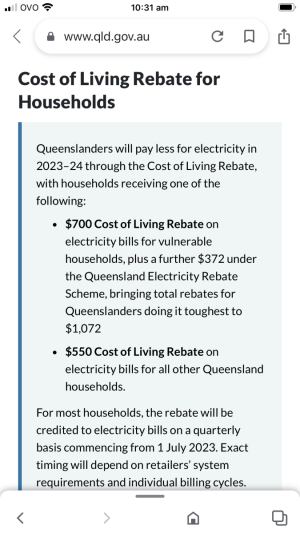Are huge savings coming? How the new cost of living measures could save you up to $500 on energy bills
- Replies 55
As many of us are painfully aware, the cost of living in Australia has been skyrocketing at an alarming rate. But don’t worry; some relief might be on the horizon.
Starting from July 1st, the federal government has decided to implement various measures to alleviate the financial burden on millions of households.
These measures, outlined in the recent federal budget, include a pay increase for aged care workers, more affordable childcare options, and adjustments to ever-increasing energy bills.
We're here to provide you with a breakdown of all these measures, so keep reading.

One of the most talked-about aspects of this new cost of living relief is a power price reduction for several households. About five million homes nationwide will be eligible for up to $500 in energy bill savings. Meanwhile, around one million small businesses can access up to $650 in energy bill relief.
It's a fantastic starting point, but there are additional steps you can take to further save on energy bills. Consider using energy-efficient appliances, solar panels, or a smart thermostat for optimal temperature control. Remember, every little bit counts, and together, these changes can significantly impact your household budget.
For more energy-saving tips, check out this article here.
Other changes include the eligibility criteria for the first home guarantee and regional first home guarantee expanding to include married and de facto couples and any two borrowers who are not necessarily in a romantic relationship.
Furthermore, individuals who are not first-time home buyers but have not owned a property in Australia within the last ten years will also be eligible for these guarantees.
Treasurer Jim Chalmers said many Australians were feeling the pinch, and these measures were designed to help.
'The suite of policies, which will start to roll out from Saturday, will make a real difference in the lives of millions of hardworking Australians while delivering an economic dividend and laying the foundations for future growth,' he said.
'Key policies like energy price relief will directly reduce inflation, while others like cheaper childcare and enhanced paid parental leave will boost the capacity of our economy.'
In the past, aged care workers' wages lagged behind their peers in other industries, prompting concerns about staff turnover and quality of care. The burden of costly childcare services also prevented many parents, especially mums, from rejoining the workforce after having children. This reduction in workers has contributed to the rising pension age.
Thanks to the government's initiatives, these areas are now being addressed.
As part of the changes, aged care workers are set for a well-deserved 15 per cent pay rise, which will likely benefit over 250,000 employees across the sector. This means nurses on an award wage stand to earn an extra $10,000 a year, while personal care workers could see an extra $7,000.

In terms of childcare, around 1.2 million families will soon find themselves paying less for their children's care. Furthermore, existing parental leave and dad and partner pay will be combined into a single 20-week scheme, which is expected to benefit about 180,000 families each year.
Education Minister Jason Clare explained that these changes aim to help businesses maintain staff levels and support parents – especially mums – in returning to the workforce.
Social Services Minister Amanda Rishworth highlighted the more flexible parental payments to promote shared care, adding that there was still more work to be done in this area. She revealed that additional legislation in the coming months will provide families with an extra six weeks of paid parental leave by 2026.

So, members, while we may not be able to slow down the rising costs of living, it seems the government is finally stepping up to help ease the cost of living pressures. Here's to hoping these measures positively impact your household budget and bring a bit of sunlight to your day!
We are eager to hear your thoughts on these changes and discover any innovative methods you have employed to save money. If you have any advice, tips, or tricks to share, please leave them in the comments below. Let's support one another in living our best lives while being mindful of our finances.
Starting from July 1st, the federal government has decided to implement various measures to alleviate the financial burden on millions of households.
These measures, outlined in the recent federal budget, include a pay increase for aged care workers, more affordable childcare options, and adjustments to ever-increasing energy bills.
We're here to provide you with a breakdown of all these measures, so keep reading.

Living relief costs are coming this week as households battle the financial squeeze. Credit: Pixabay/Pexels.
One of the most talked-about aspects of this new cost of living relief is a power price reduction for several households. About five million homes nationwide will be eligible for up to $500 in energy bill savings. Meanwhile, around one million small businesses can access up to $650 in energy bill relief.
It's a fantastic starting point, but there are additional steps you can take to further save on energy bills. Consider using energy-efficient appliances, solar panels, or a smart thermostat for optimal temperature control. Remember, every little bit counts, and together, these changes can significantly impact your household budget.
For more energy-saving tips, check out this article here.
Other changes include the eligibility criteria for the first home guarantee and regional first home guarantee expanding to include married and de facto couples and any two borrowers who are not necessarily in a romantic relationship.
Furthermore, individuals who are not first-time home buyers but have not owned a property in Australia within the last ten years will also be eligible for these guarantees.
Treasurer Jim Chalmers said many Australians were feeling the pinch, and these measures were designed to help.
'The suite of policies, which will start to roll out from Saturday, will make a real difference in the lives of millions of hardworking Australians while delivering an economic dividend and laying the foundations for future growth,' he said.
'Key policies like energy price relief will directly reduce inflation, while others like cheaper childcare and enhanced paid parental leave will boost the capacity of our economy.'
In the past, aged care workers' wages lagged behind their peers in other industries, prompting concerns about staff turnover and quality of care. The burden of costly childcare services also prevented many parents, especially mums, from rejoining the workforce after having children. This reduction in workers has contributed to the rising pension age.
Thanks to the government's initiatives, these areas are now being addressed.
As part of the changes, aged care workers are set for a well-deserved 15 per cent pay rise, which will likely benefit over 250,000 employees across the sector. This means nurses on an award wage stand to earn an extra $10,000 a year, while personal care workers could see an extra $7,000.

Millions of families are set to benefit from reduced childcare costs. Credit: Pexels/RDNE Stock project.
In terms of childcare, around 1.2 million families will soon find themselves paying less for their children's care. Furthermore, existing parental leave and dad and partner pay will be combined into a single 20-week scheme, which is expected to benefit about 180,000 families each year.
Education Minister Jason Clare explained that these changes aim to help businesses maintain staff levels and support parents – especially mums – in returning to the workforce.
Social Services Minister Amanda Rishworth highlighted the more flexible parental payments to promote shared care, adding that there was still more work to be done in this area. She revealed that additional legislation in the coming months will provide families with an extra six weeks of paid parental leave by 2026.
Key Takeaways
- The federal government promises measures to ease the cost of living, including a 15 per cent pay rise for aged care workers, cheaper childcare, and changes to paid parental leave starting July 1.
- Electricity bill relief will be provided for some households, and a small business incentive will help eligible businesses become more energy efficient.
- Eligibility for the first home and regional home guarantees will be expanded to include any two borrowers and non-first home buyers who have not owned a property in Australia in the past ten years.
- More than 250,000 aged care workers will benefit from the pay rise, five million households will be eligible for up to $500 in power price relief, and around 1.2 million families will pay less for childcare.
So, members, while we may not be able to slow down the rising costs of living, it seems the government is finally stepping up to help ease the cost of living pressures. Here's to hoping these measures positively impact your household budget and bring a bit of sunlight to your day!
We are eager to hear your thoughts on these changes and discover any innovative methods you have employed to save money. If you have any advice, tips, or tricks to share, please leave them in the comments below. Let's support one another in living our best lives while being mindful of our finances.









